Summer was starting.
Grading was over.
We rode to the skate parks to explore
the city.
Meeting in the West Village, Tim and Mel
told me about their year.
It was hard.
ALS and Covid, the blues hit.
But that was then.
Summer was here.
Tim was telling me about his exploits in
the East Village and NOLA.
The next morning, we made our way out to
slow it down.
It all blurs.
A younger singer stood outside of 4229 Dauphine St, New Orleans, her
debut at Vaughan’s, the iconic 9th
Ward Music venue, singing:
“Summertime and the
livin' is easy”
She hit the deep note
perfectly.
Oh
my god, said the elder man sitting on the street in front of me, applauding.
The
teenager and I look at each other.
We’d
been listening to Janis Japlin sing this song over and over again when she was
a kid, when I was baby sitting taking care of her.
“Fish are jumpin' and the cotton is high
Oh, your daddy's rich and your ma is good lookin'
So hush, little baby, don't you cry
One of these mornings
You're gonna rise up singin'
Yes, you'll spread your wings
And you'll take to the sky…”
She was born in 2005 after the storm....I’d
been at this club the previous fall, seeing Kermit play there on
one of those late Thursday nights back in 2004.
This is our third
trip to NOLA together, the teenager and I, our second on our own.
We’d only arrived a
couple nights before, staying at Balcony Guest House on Royal
Street in our favorite neighborhood, the
Faubourg Marigny.
My frequent hosts
Erin and Kevin describe it as:
“.. a wonderful
18th and 19th century neighborhood, which was the first “suburb”
of New Orleans that was developed outside of the original city limits – The
French Quarter. The neighborhood is an
eclectic mix of professionals, artists, writers, hipsters, bohemians and
old-timers. The neighborhood is bound on
the north by St. Claude Ave (the major intersection to the left of the house)
on the south by the river, on the east by the French Quarter (Esplanade Ave)
and on the west by Press St and the railroad tracks. On the other side of Press St and the
railroad tracks but within the same north/south boundary is our sister
neighborhood, the Bywater, which is very similar to the Marigny... The
neighborhood on the other side of St. Claude Ave, which is the major street at
the left end of the block is a bit different than the Marigny and Bywater.”
We spend the next
few days exploring the spaces between the trees of the Esplinade and the View
Carre, the “Old Square” Marigny and the Bywater, walking along Dauphine, my
favorite street in the city. Most of the time I’m here I’m trying to make sense
of the past, within this unique space and its mix of cultures, free men, the colonized
and colonizers, Spanish, French, and the US, Creole and Cajuns flavors,
overlapping. I always forget whose who, and whose spices came from where in this
distinct mix. Houma puts it: the Creole “mixed colonial French,
African American and Native American ancestry. The term Black Creole refers to
freed slaves from Haiti and their descendants. Still another class of Creole originates with the placage
system in which white and creole men took on mixed-race mistresses in a
lifelong arrangement…In this arrangement, the women had property, their
children were educated and entitled to part of the man’s estate upon his death.
In New Orleans, these people made up the artisan class and became wealthy and
very influential. “Cajun” is derived from “Acadian” which are the people the
modern day Cajuns descend from. These were the French immigrants who were
expelled from Nova Scotia, and eventually landed in Louisiana after decades of
hardship and exile.” And they
are still here, informing this distinct space. Some call it the northern most city
of the Caribbean, a trade port between the Caribbean and the Mississippi to the
north.
Walking
past the Esplanade, I look at the trees across the thoroughfare, the crusty punks
on the corner, the shadows, the memories, the vampires and magic.
Anne
Rice, author of Interview with a Vampire, used to live here. She writes
“But during all these
years I had a vague but persistent desire to return to New Orleans. I never
forgot New Orleans. And when we were in tropical places and places of those
flowers and trees that grow in Louisiana, I would think of it acutely and I
would feel for my home the only glimmer of desire I felt for anything… .”
Many of us have that feeling.
I have it as we sit
listening to Dixie Jazz at Bamboula's on Frenchman Street eating friend pickles
and catfish.
“There will be other
songs to sing. There will never be
another you,” the band sings.
Our waitress pulled an
all nightery the previous night.
But she’s in a good mood, making sure everything is coming.
I scour the music
listings.
Kermit is playing at
the Magnolia Mansion in the Garden District; his shows always offer a mix Red
Beans and rice and jazz. So we make our way over:
“Grab your coat
Don't forget your hat
But leave your worries
Leave 'em on the doorstep
Just direct your feet
To the sunny side of
the street…” he sings,
sounding more and more
like Satchmo, who sang this song, before him, as did Billy.
We only stay for a bit.
Our friend Anne
Christine wants to meet at the Artisan Café on St Claude.
The author of The Pox
Lover, a memoir of the turbulent 1990s in New York City and Paris, d'
Friday.
Coffee
pouring,
I
wake with a bit of the Magic Mountain, Thomas Mann’s novel of seven
years in a sanitarium.
By
945 AM, we drop by Flora Gallery and Coffee Shop, down the street from the
Balcony Guest House. On the way, we pass
Big
Daddy's Bar, where people are still drinking. Caroline had that whisky here that took her
out before we went to Galatoire's a few years ago.
The
simple breakfast at Flora is an ideal way to start a day of touring about, words
and music, images dancing from the room.
Jesse,
the teenager’s friend, jumps on the piano, playing us a medley of songs from
Hunky Dorey, life in mars, etc. A Church of Stop Shopping EarthRiot jacket
patch hangs in the back.
I
read a zine titled, “More Poems about Bro Sex and Bohemian Lifestyle.” And scour
the set lists for the night. There’s DBA
where the Rebirth Brass Band is playing and Treme Brass Band at Vaughan’s and
the AllWays Lounge and Cabaret on St Claude, for burlesque shows.
Its
almost more than I can plan for.
After
breakfast, we walk down Dauphine, taking in the smells, the quirky houses on
the way to Frady’s One Stop, an oddball grocery, which offers po’ boys and deviled
eggs on 3231 Dauphine; the owner is obsessed with
Luci Ball.
Greetings Ben and Dodi,
says the always amiable owner, Dodi, I missed you. Welcome back, he says, chatting
away, sometimes about Luci Ball, sometimes about arriving at 5 AM every
morning, except Saturday, when he sleeps in and arrives at 545.
Frady’s is on Dauphine
and Penitence,
the best corner porch
around.
It’s usually an early
stop on my trips here.
Down the street from
our favorite junk shop, up the street from my favorite cross street here,
Dauphine and Desire.
Seems every street
corner is teeming with stories, poetry itself.
We walk toward the
end of the world, a decommissioned old military base, turned squat, with mutual
aid corner and whimsical murals and graffiti.
People are milling
about, having slept there.
This is what the
world might look like if we all slowed down.
The teenagers see it
as a space between utopia and dystopia, somewhere between this world and another,
this life and another, between a dream life and these walking days.
Walking through it, you
see syringes on the ground and hear voices inside.
I think of what Anne
said the night before.
“I have lived in
Haiti. I have seen a life without
government. I want a little government…”
To beat the heat, we stop
at Bacchanal, a wine-&-cheese bar offering live music in a shady back patio,
with lots of fans and a fresh breeze at 600 Poland Ave.
The Tangiers Combo, a
Mediterranean infused jazz group, of guitar and accordion, is playing in the
back.
“I
Love Paris,” is their first song, with transcontinental vibe filling the back yard.
All
week, world music overlaps with a traditional New Orleans repertoire.
A
little jazz and a breeze, some cheese and a Pimms cup is just what the doctor ordered.
“I
think you need a new doctor,” says the Teenager.
She’s
probably right.
Music all day long,
from Bacchanal
to Vaughans, where we enjoy some crawfish, tunes and friendship, kids dancing
with their parents the Treme Brass Band, doing summersaults in front of us.
Scotty pulls over to
greet us, inviting us to see more jazz afterward.
We miss the
musicians.
But Anne Christine
and Scott chat away.
Anne regales us with
stories about Lesbian Avengers, activist strategies, and dangerous alligators
and they ride home.
The teenagers get turned away from the Always Cabaret, a lounge on St Claude,
putting on burlesque shows.
Its hard to shake the
Sally Bowles dream of a never never clubland, where all life is a cabaret.
But unlike my days on
Bourbon Street when I was 16, they are getting carded a lot.
The blues grasp. We go our separate ways.
I catch some karaoke and
keep on walking through the masses making their way through this majestic city. The smell of vomit becomes all the more pronounced
the closer we get to the quarter, where I found that Big Daddy’s, a strip club
where I used to hang out as a teenager, was closed.
My mind wonders back
to a night I stayed all night high on crystal meth, meeting new friends, with
my brother, and Matteo. And the city
opened up right there. Many have similar
memories:
"It
was what it was, and it was really pure."
Cities are always
changing.
This is the only
constant of city life.
On Frenchman Street, people
are screaming inside Café Negil.
I walk inside and its
like a religious revival.
Drinks in hand, hands
in the air, everyone is singing along:
“Woah
Woah-oah-ah-ah-ah uh, uh
La-la-la, la, la, la
Woah, la
Woah, la (ha, ha, ha, ha)
La-ah-ah-ah-ah
Strumming my pain with
his fingers (yes, he was singing my life)
Singing my life with his words
Killing me softly with his song
Killing me softly with his song
Telling my whole life with his words
Killing me softly with his song..”
Roberta would have
been proud.
It wasn’t the last
time I heard these words on this trip.
The exuberance cleans
some of the desperate 42nd Street, Bourbon Street vibe.
More music fills the
street outside, a tuba player and drummer holding a beat, with a circle cheering
them on. Some of the people who were at Vaughan’s
hours earlier are still out dancing.
We all are.
Saturday.
We sleep in the next
morning. The Magic Mountain and a cup of coffee help welcome the day,
dreams of witches and magic, illness and death, life and transcendence propel
the story. Not much plot, but it is
oddly comforting, helping me make my way through the haze of morning.
By this point, it
feels like we’ve been in town for days.
Our routine begins
with a breakfast at Flora, maybe some piano.
The teenagers had a
rough time the night before, stumbling into a friend from New York, who seemed
lost, and not in a good way.
Its one thing to
romanticize jumping trains. The reality of poverty, the sensation of being strung
out – is anything bur romantic.
But the sun is shining.
We stroll back to Frady’s and the Bargain Center of Dauphine.
Ruth, one of the owners
is sitting smoking a cigarette outside.
“I like it here. You see kids. And the Second Line Parades every
day, for no reason,” she tells me, recalling her years here.
At Frady’s a line runs
out the door. I sit outside drinking a
sweat tea, talking with a few of the others. “The deviled eggs here are my
favorites,” a younger black man tells me. “They are always kind to me inside.” He pauses, reflecting on the years he spent
outside of the city after Katrina, displaced and drifting. “New Orleans is the
only place I know where people help each other out. If you are in trouble, people help you here. In New Orleans, they help you if you need
help. They don’t do that in other
places, not at all. They helped me find housing,” he tells me.
The conversation
gradually shifts to cemeteries nearby. A
few folks on the bench suggest we walk to St Vincent and then to St Roch Cemeteries
– both in walking distance.
“Are you tourists,”
asks a man at St Vincent Cemetery. For
the next hour, he tells me about things. “My mother is there. My brother is there,” he explains, pointing. “I
am going to be there,” he says, pointing in the same direction. “The graves are
above ground because under the ground, the water preserves the bodies. And it spreads disease.” Whole families are
buried in one tomb.
They have to go in and re cremate them.”
From graveyards to
rates of mortality after the Civil War to Creole and Cajun histories, the
conversation goes on and on and on about the dead, the ways they bury and
remember them here, the rituals and economics and land use questions of piling
bodies in a flood plane. “It only went up about three feet here during Katrina.”
Cemeteries are gateways to conversations about morality and mortality. I could
keep talking all day. But the kids are getting anxious.
That afternoon we find
ourselves walking through the quarter.
Outside
of Jackson Square, its hard not to think about who drafted his Confederacy
of Dunces about this space, an
homage to a hotdog vendor’s existential struggle amidst the ruins, failing to
procure a book contract in his lifetime.
“I am an anachronism. People realize this and resent it,” he
writes. His novel never saw the light of
day, not until after he killed himself and his mother took the manuscript to Walker
Percy, the literary lion of New Orleans. He saw something in Toole’s homage to this
sentiment, his words, capturing the feeling:
“... I tried to end our little duel. I called out pacifying
words; I entreated; I finally surrendered. Still Clyde came, … apparently
convinced … we were back in the golden days of romantic old New Orleans when
gentlemen decided matters of … honor at twenty paces…”
Like the hotdog vender Toole describes, people are selling their
wares throughout the square. Walking
up to the Cabildo, where the Spanish signed the deed to the French and the
French signed the deed to the United States, history feels very present here. It’s
good to be reminded. We sit looking at it all. And then make our way, through a
side street.
Behind Pirate’s Alley,
we take in Faulkner’s old home. Faulkner drafted his first novel here, trapsing
about with his friend Sherwood. Anderson’s short story “A
Meeting South,” conserns evening with himself and Aunt Sally, a grand New
Orleans, chatting with a young writer, wounded in war and with too much drink:
“He told me the story of his ill fortune-…I liked his tone and I
liked him. This happened in New Orleans, where I had gone
to live. When he came, my friend, Fred, for whom he was looking, had gone away,
but immediately I felt a strong desire to know him better and so suggested we
spend the evening together. When we went down the stairs from my apartment…”
The story is about what happened there. The character is thought
to be a young Faulkner who caroused with Anderson for a number of years here,
while drafting his first novel, before the two had a falling out.
The days getting hotter and hotter. We need a break from the
sun. Before we know it, we are deep into red beans and rice at Buffa’s on the Esplanade, and back to Vaughan’s.
Sunday
The Magic Mountain is getting better and better.
Her friend left so we
go to breakfast on our own, recounting the people we’ve met here, the
Brooklynites, the writers from Hells Kitchen, on and on, Remmy, from
Williamsburg, who spends a month here a year, a week every few months.
We talk about dreams
and where to live a life, where we work harder or in a dreamscape such as this?
At Flora, we listen to
a younger couple play the piano, thinking about time passing, the summer coming
up, and then the fall when she moves out West to make her own life.
Kids grow and make
their own lives.
So, we enjoy the time
we have.
Anne Christine shows us
her photos and books and we chat about writing and the city in flux.
Books
such as Force of Circumstance by Simone de Beauvoir, Janet
Flanner's World: Uncollected Writings, and sylvia beach
and the lost generation - they show her how to write.
All afternoon we explore
St Roach’s cemetery.
And we make our way
back to Flora for pecan pie and sweet tea, talking about what we’ve seen. The quirky,
street graffiti is striking and whimsical.
The teenager sketches impressions.
The people live well here.
That night we finally
get reservations for Galatoire’s, a century-old spot serving French-Creole fare
at 209 Bourbon Street, that’s my favorite place to eat. My family has eaten there
for generations. We get a spot on the first floor. The last time she was here, her Grandad brought
her a few days before the storm.
Today, Bev and her
grandfather, who met her on that trip with us are gone. But the restaurant is
still there.
The same gumbo and
escargot, opened memories, the
same ghosts of meals with dad.
The teenager and I
talk about where its all going, all the adventures she’s had and is going to have,
opening her wings to fly, thinking about Sally Bowles, off to the end of the
world.
Monday
We walk back to the end
of the world, reflecting on the decommissioned military base, turned mutual
aid, squat, art space and bird sanctuary.
“It reminds me of utopia,” says the teenager,
looking at the graffiti.
“I hope you find all
you seek” says the labyrinth.
“Open your heard to love…”
Back we walk, past
Vaughans, now empty, a worker in back preparing for the day of crawfish and red
beans and rice, and live music.
The art of living is
wondrous here.
Words of the street, “Stop
Killing people”
“Your joy inscribed
itself on the sidewalk and it has never been washed away,” says another mural.
Past the railroad
tracks, past Desire, we stroll, back to Penitence and Frady’s and our friends
and memories or eating at Galatoire’s and Dad
and Bev 16 years ago. Before they headed
back to Texas, Katrina hit, and they passed.
And COVID came and the world changed.
And that little girl is about to take her wings and fly, away from Flora,
Brooklyn in the distance.
































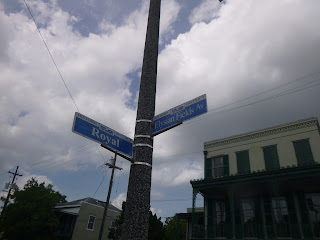


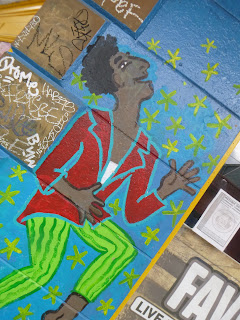
























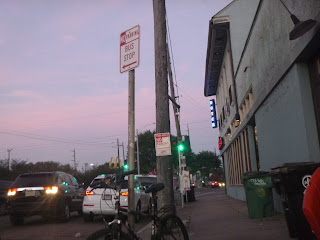
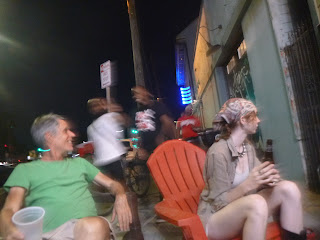
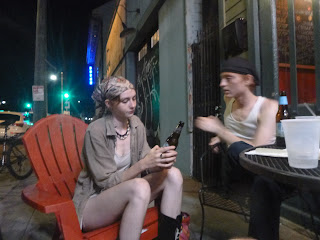

















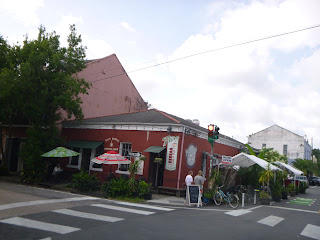












































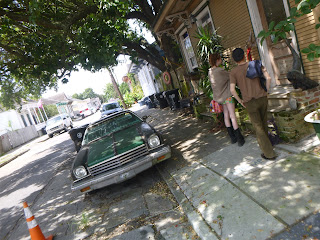



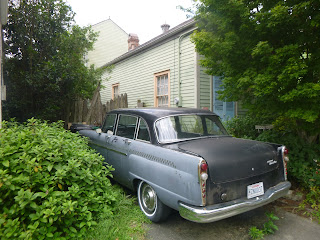





















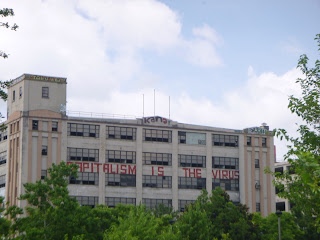



























































































































































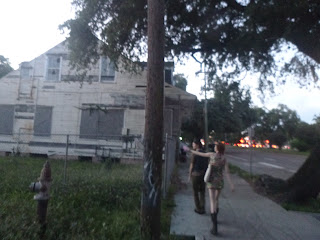

































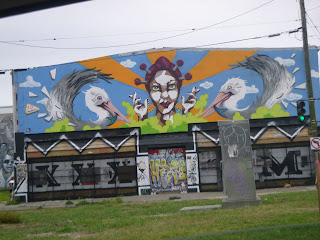


































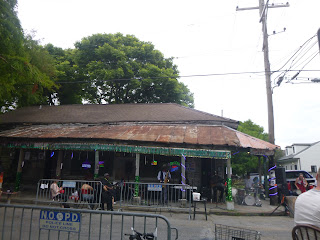


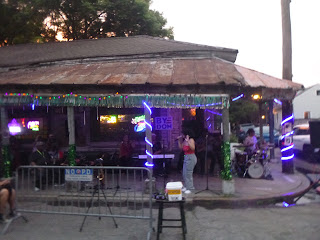

















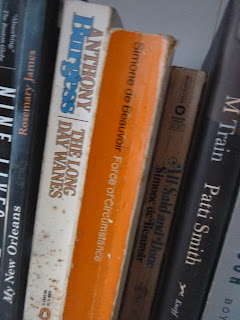




































































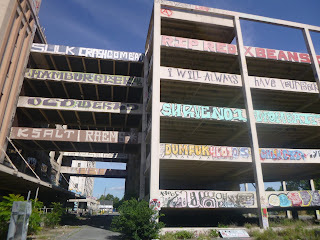
















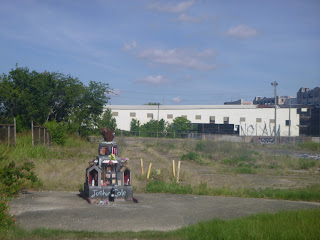
























This comment has been removed by a blog administrator.
ReplyDelete